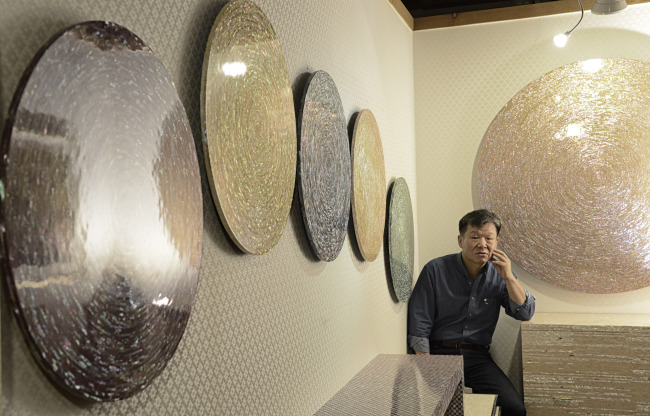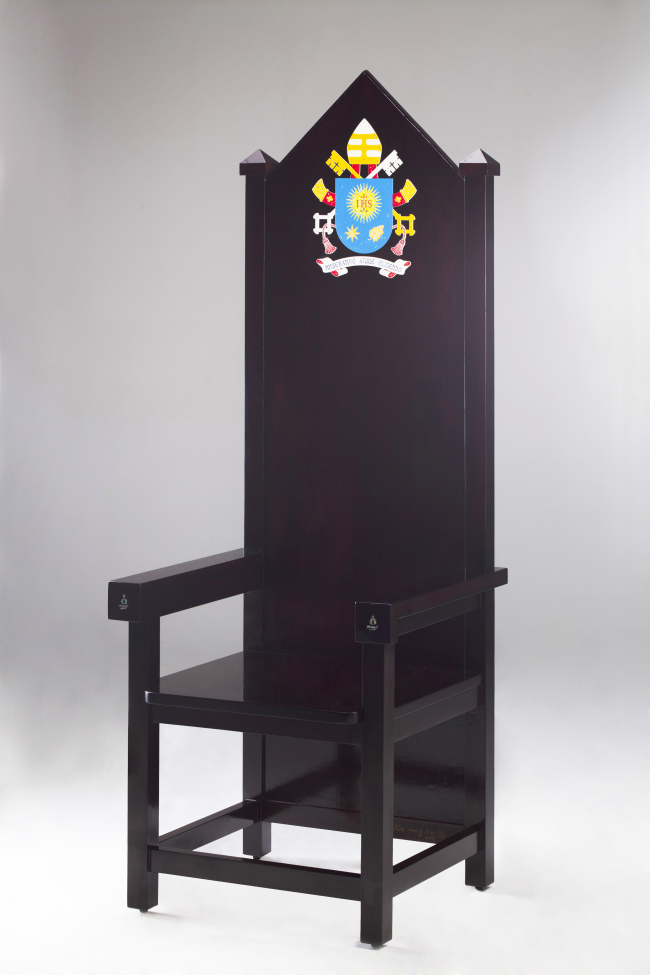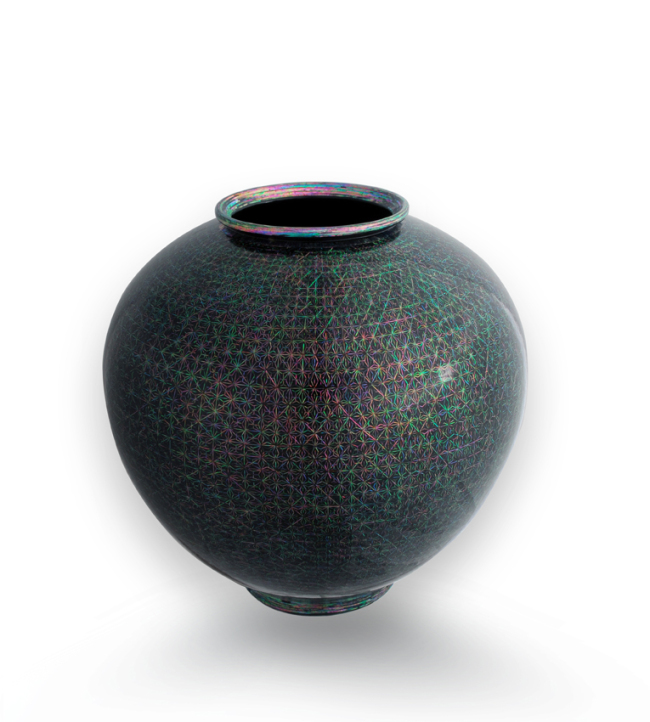Transforming centuries-old artistry
Stock manager-turned-artist Kim Young-jun incorporates simplicity, functionality into time-honored art
By Lee Woo-youngPublished : Oct. 17, 2014 - 21:17
Kim Young-jun was a star stock manager in the 1980s and 1990s when the Korean economy was on the rise, registering strong growth. He gave financial advice on TV and radio, and also wrote two books on stock investments.
“I was a celebrity in finance,” said Kim.
His advice proved worth heeding most of the time. The rule was, he said, invest when others don’t.
Then, suddenly, he realized that all his life was built around the hollow world of the stock market.
“I felt like I was a robot chasing money. I had a moment of self-reflection. I said to myself, ‘I shouldn’t waste my life anymore, living as a slave of money,’” he said.
In 1994, at the age of 35, he quit the high-paying job and decided to attend a design school in the United States.
Planning his future in the creative field, he stuck to the one rule he learned from a decadelong career in the stock market ― do the opposite of what others do.
He decided to devote himself to lacquer and mother-of-pearl art ― centuries-old craftsmanship that was on the decline at that time.
“I grew up surrounded by lacquered furniture inlaid with mother-of-pearl at home. My mother loved them. I always had an eye for design and traditional pieces,” he said.
“I was a celebrity in finance,” said Kim.
His advice proved worth heeding most of the time. The rule was, he said, invest when others don’t.
Then, suddenly, he realized that all his life was built around the hollow world of the stock market.
“I felt like I was a robot chasing money. I had a moment of self-reflection. I said to myself, ‘I shouldn’t waste my life anymore, living as a slave of money,’” he said.
In 1994, at the age of 35, he quit the high-paying job and decided to attend a design school in the United States.
Planning his future in the creative field, he stuck to the one rule he learned from a decadelong career in the stock market ― do the opposite of what others do.
He decided to devote himself to lacquer and mother-of-pearl art ― centuries-old craftsmanship that was on the decline at that time.
“I grew up surrounded by lacquered furniture inlaid with mother-of-pearl at home. My mother loved them. I always had an eye for design and traditional pieces,” he said.

Korea is well-known for fine lacquerware with mother-of-pearl inlays.
Traditional lacquered furniture was once considered one of the most valuable wedding gifts that parents could give their daughters.
But as modern lifestyle took over tradition, Korean homes have fast adopted Western home interiors.
Many young Koreans now regard lacquered furniture as old-fashioned and outdated.
To acquire the necessary skills, Kim visited lacquer and mother-of-pearl artisans around the country.
Their level of craftsmanship ― passed down from generation to generation and perfected through years of practice ― was peerless, but Kim was disappointed by the final products.
“They were almost the same. Mother-of-pearl inlays in traditional patterns of deer and crane on the black lacquered wooden surface. The problem was people didn’t want the typical traditional style anymore,” he said.
“They prefer Western-style simple furniture that offers functionality.”
So, instead of becoming an apprentice of a renowned artisan, Kim went independent.
He started to take unprecedented approaches to the traditional art.
He added vivid colors to mother-of-pearl fragments, originally in white and subtle pink and yellow. With the addition of a variety of colors, he created a mother-of-pearl painting like a real painting with depth.
As the design changed, so did the methods.
He automated the process of extracting the pure lacquer from the sap of a lacquer tree, which previously used to be done by hand.
“The old method wasn’t efficient to remove impurities and moisture from the original lacquer liquid.”
He holds two patents in the processing of lacquer liquid and the coloring of mother-of-pearl.
At his studio in Pocheon, Gyeonggi Province, a couple of old lacquered closets inlaid with thick white and yellow mother-of-pearl are ready to be transformed into a modern design.
“My clients asked me to redesign them in a more modern fashion,” Kim said.
His furniture pieces pursue both simplicity and functionality on top of modern design. A white console is decorated with round mother-of-pearl inlays, which look like polka dots. Modern chairs and tables are also inlaid with slices and cuts of mother-or-pearl and abalone shells to add traditional sophistication.
He also creates wall paintings and wall hangings. Thinly sliced abalone shells circle in a whirl against the salmon pink lacquer background. Another wall hanging features fiber-optic cables implanted on the lacquered panel inlaid with abalone shells, giving off subtle light. In his recent exhibition at Hankyung Gallery in Seoul, he presented a variety of wall hangings in vibrant red, orange, yellow and blue.
“I started creating my simple and abstract works five years ago,” said Kim.
The modern lacquer and mother-of-pearl artworks launched him on a high-flying career.
He shot to fame by making inlaid versions of Microsoft’s video game console Xbox on the order of Bill Gates. A string of artistic collaborations with other companies have since followed. He made a lacquered box inlaid with mother-of-pearl for the limited cosmetic edition of Coreana Cosmetics, and a whiskey box for the Scotch whiskey brand Glenlivet.
Kim’s modern lacquerware soon became a popular gift item that Koreans give to foreign guests. Some of famous owners of his creations include Warren Buffet and Hilary Clinton.
He was named the Korean Master of Varnishing by the Association of Korean Masters in 2010.
New approaches to the old-fashioned art brought him success, but Kim believes he must carry on the essence of the centuries-old tradition ― dedication to craftsmanship.
That was what drove the artist to spend 15 years on a wooden closet, which stands in a corner of his studio. He applied lacquer on the wood over and over until the wood completely dried up. “While I was still applying lacquer, the artisan who made the wood closet died,” Kim said.
With such commitment and dedication, he made a lacquered chair for Pope Francis, who visited South Korea in August.
The idea was proposed by priest Hong Moon-taek of a Catholic girls’ art school where Kim regularly teaches voluntarily. The lacquered wooden chair with the papal symbol engraved on the back was used for the historic mass to beatify Korean martyrs in Gwanghwamun.

Kim applied more than 10 extra layers of lacquer and put the golden papal symbol not on the front, but on the back of the chair, as the pontiff is famous for his humble lifestyle.
On each layer of lacquer, the chair was put into a lacquer cellar kept at 26 degrees Celsius with 78 percent moisture for a couple of days to dry.
“The chair was made (to honor) the pope’s humbleness and goodwill. I kept in mind his goodwill while applying each layer of lacquer,” said Kim.

This is the spirit that Kim keeps in mind while applying each layer of lacquer and slices of mother-of-pearl.
The moon jar inlaid with thinly sliced abalone shells is the epitome of his artistry. It requires delicate craftsmanship and intuitive aesthetics to attach a 0.1 millimeter-thin slice of abalone shell one by one onto the moon jar that symbolizes Korean beauty.
His works will be shown at several overseas exhibitions starting at the Shanghai Art Fair in November. He plans to hold more exhibitions next year, including one at the National Museum in Malaysia.
By Lee Woo-young (wylee@heraldcorp.com)




![[Herald Interview] 'Amid aging population, Korea to invite more young professionals from overseas'](http://res.heraldm.com/phpwas/restmb_idxmake.php?idx=644&simg=/content/image/2024/04/24/20240424050844_0.jpg&u=20240424200058)












![[KH Explains] Korean shipbuilding stocks rally: Real growth or bubble?](http://res.heraldm.com/phpwas/restmb_idxmake.php?idx=652&simg=/content/image/2024/04/25/20240425050656_0.jpg&u=)

